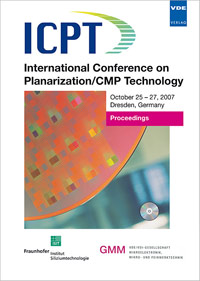TaN Cup Formation by CMP for Cross-Spacered Phase Change Memory
Conference: ICPT 2007 - International Conference on Planarization / CMP Technology
10/25/2007 - 10/27/2007 at Dresden, Germany
Proceedings: ICPT 2007
Pages: 4Language: englishTyp: PDF
Personal VDE Members are entitled to a 10% discount on this title
Authors:
Lin, Ke-Chin; Chen, Chih-Wei; Wang, Shih-Hui; Shu, Dun-Ying; Kao, Ming-Jer; Tsai, Ming-Jinn (Electronics and Optoelectronics Research Lab., Industrial Technology Research Institute, Hsinchu, Taiwan)
Abstract:
The Phase Change Memory is one of the most promising new non-volatile memories because of the advantages of speed, reliability and probably, most of all, scalability as compared to the current Flash devices. For further size scaling, the programming current to induce phase change, which determines the size of the switching device has to be reduced. Among the many methods proposed to reduce the reset current, the cross-spacered phase change memory structure that adopts the thickness of the metal and phase change material films as the contacting area, by-passing the lithographic limitation, is highly plausible for mass production in the next few years. For the fabrication of cross-spacered structure, a flat cup made of TaN film in the vicinity of oxide and nitride has to be formed first, which imposes a great challenge to the CMP process for end-point detection and erosion control. In this study, sequential observations of the CMP steps are conducted to monitor the effects of slurry and polishing speed. Optimal results are verified by the cross-section images as well as electrical performance. Suggestions for best cup geometry are also made.


